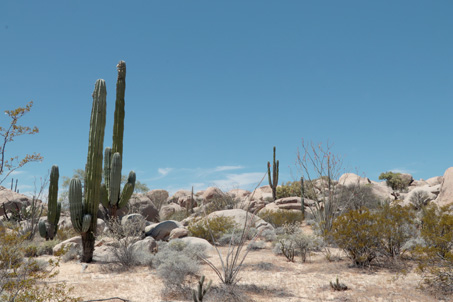This section contains entries about our botanizing in Baja California written for the UC BEE (Oct 2012 to Aug 2021)
and The UC Bee Hive (2022-), monthly newsletters for volunteers and staff of the UC Berkeley Botanical Garden.
Click on any photo for a larger image.
BEE JUNE 2019
Guerrero Negro and Baja California Norte
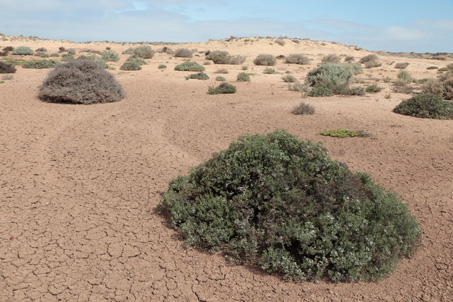
I sense a drag race happening here.
This month our latest season in Baja California unfortunately came to an end and we had to head back to California. In this entry, we share some highlights of the trip to the border.
Friends who had made the trip in March reported that the scenery had been very green at the time and that the wildflowers were spectacular in some areas, especially north of Cataviña. We didn't see many flowers until our first stop, Guerrero Negro in the Vizcaino Desert. Time was spent wandering around in the dunes and salt flat areas, both near where we were staying and along the highway farther north. Below are some of the species we encountered on our April return trip.
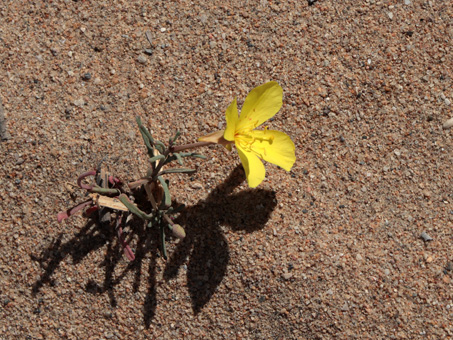
Baja California Sun Cup (Eulobus angelorum, Onagraceae), an endemic herb. This is a tiny specimen just about 5-8 cm H. More often, they reach 50-60 cm H.
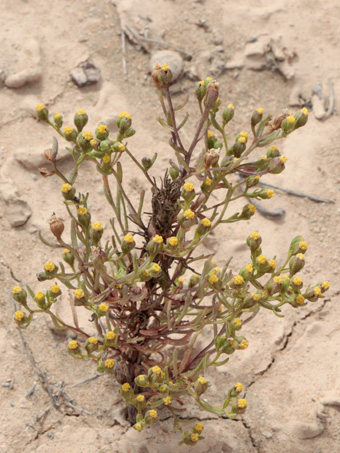
Pineapple-weed (Amblyopappus pusillus, Asteraceae). A common plant in the area. I've found it over many years, like this one, in dry depressions in the dune swales where rainwater had collected.
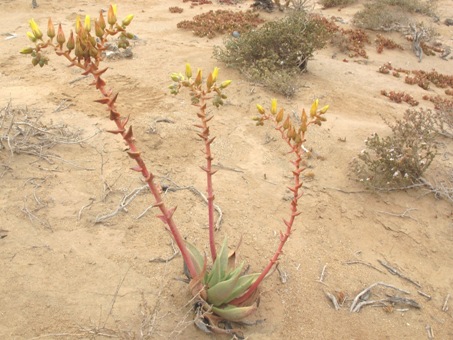
Vizcaíno Liveforever, Siempreviva
(Dudleya acuminata, Crassulaceae).
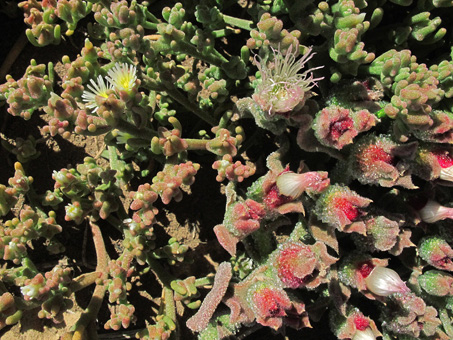
Two species of non-native, invasive Iceplant: Slender-Leaf Iceplant/Hielitos (Mesembryanthum nodiflorum, left) and Crystalline Iceplant/Hielitos or Vidriero (M. crystallinum, right bottom).
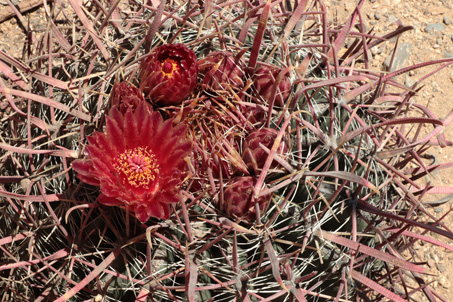
Red-Spine Barrel Cactus, Biznaga (Ferocactus gracilis, Cactaceae), a common endemic to the Central Desert region.
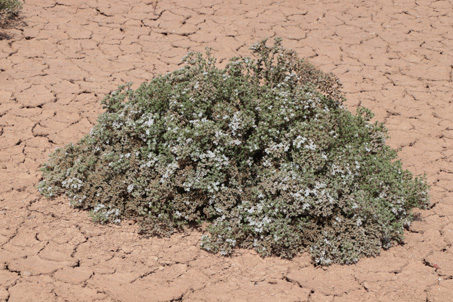
Palmer Frankenia/Yerba Reuma (Frankenia palmeri, Frankeniaceae). Plants in bloom varied from 30 cm D to 130 cm D, like the one above.
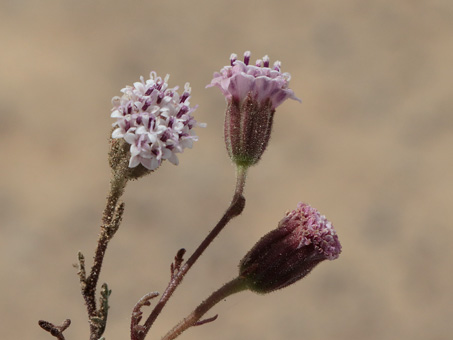
Vizcaíno Pincushion (Chaenactis lacera, Asteraceae). These can occur by the hundreds in a few square meters, but I only found 3 on several excursions into the dunes.
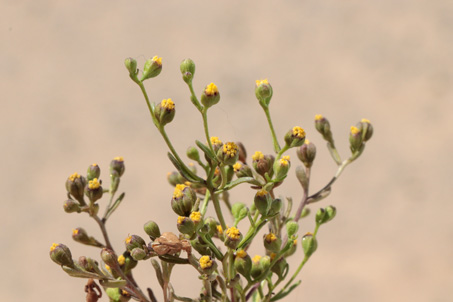
Pineapple-weed plants are small, usually up to about 30 cm H. Flowers are about 7-9 mm L and lack rays. The herbage is resiny, slightly tacky, and has a sweet pineapple-like odor.
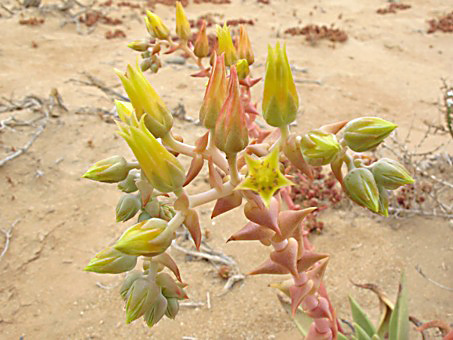
Vizcaíno Liveforever, Siempreviva
(Dudleya acuminata, Crassulaceae).
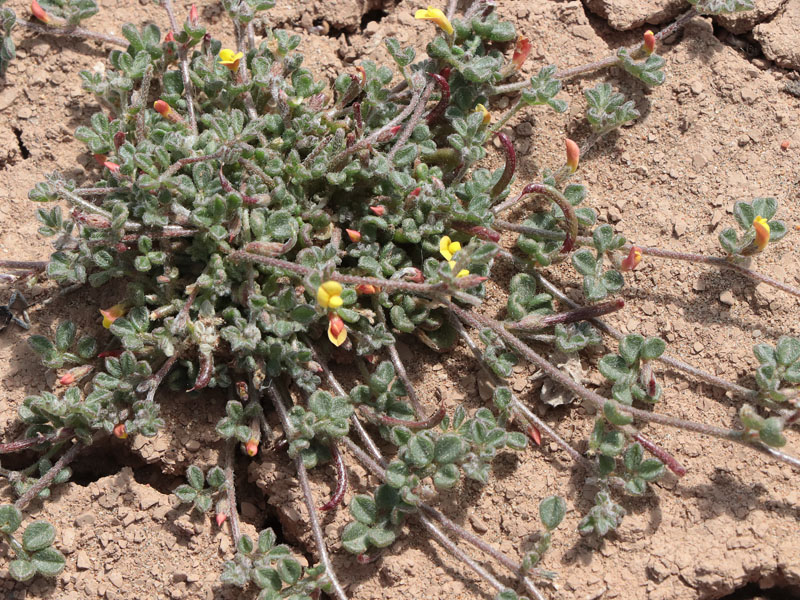
A species of annual Lotus. Designed for life in the salty soil of the dunes and swales, the leaves are quite succulent.
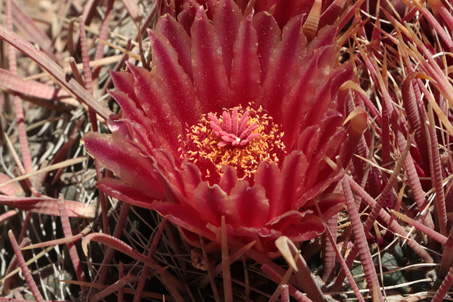
Red-Spine Barrel Cactus, Biznaga (Ferocactus gracilis, Cactaceae).
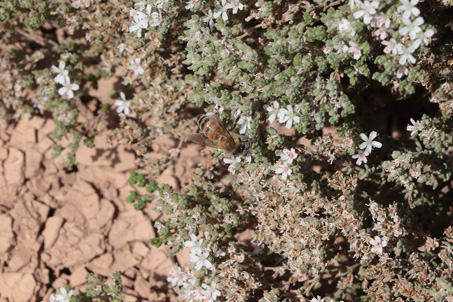
Honey bee on Palmer Frankenia (Frankenia palmeri). Flowers are about 8-10 mm D, white with pinkish red anthers.
Central Desert near Punta Prieta, BC

We stopped somewhere around Km 255 south of Cataviña to check out all the flowering Chollas. While wandering not far from the road, we saw a lot of other species in bloom.
Below are just a few of them. Other species included: Creosote (Larrea tridentata); Ocotillo (Fouquieria splendens), Palo Adán (F. diguetii), Tree Yucca/Datilillo (Yucca valida), Long-spine Cholla (Cylindropuntia molesta var. molesta), Red-spine Barrel Cactus (Ferocactus gracilis var. gracilis), Hummingbird bush/Chuparrosa (Justicia californica), Mesquite (Prosopis glandulosa var. torreyana) and San Diego Goldeneye/Margaritas or Flor de Mayo (Bahiopsis laciniata).
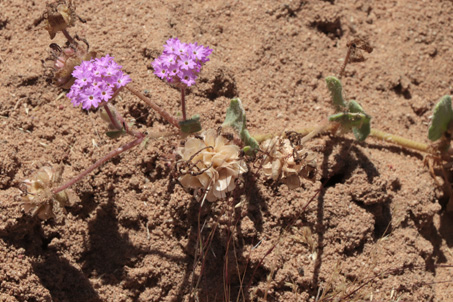
Desert Sand Verbena (Abronia villosa var. villosa, Nyctaginaceae).
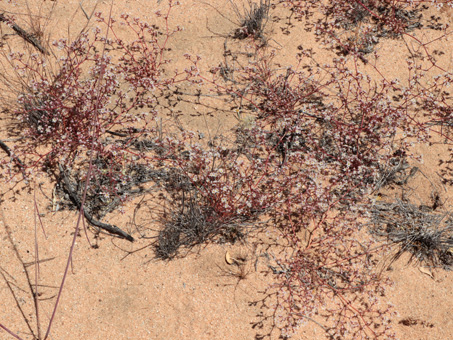
Fringed Spineflower (Chorizanthe fimbriata var. laciniata, Polygonaceae), a native to the region and extending into California.
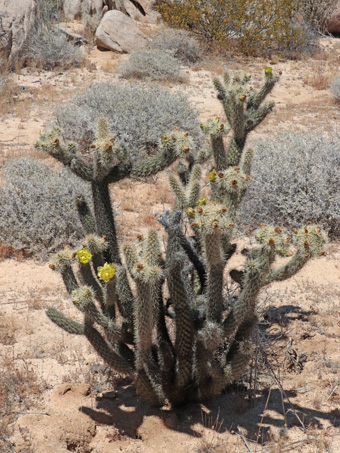
The Cataviña Cholla (Cylindropuntia ganderi var. catavinensis) were blooming copiously throughout the Central Desert.
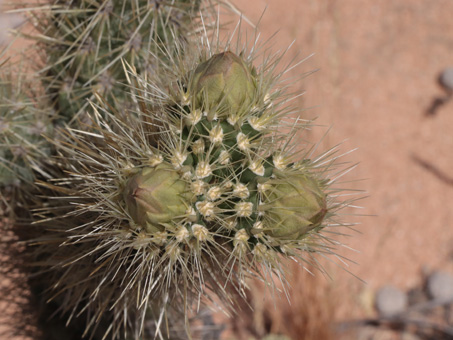
All the Cholla plants were full of buds...
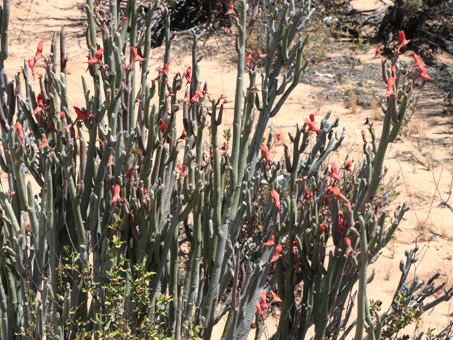
Slipper Plant/Candelilla (Euphorbia lomelii). The flowers are hummingbird pollinated.
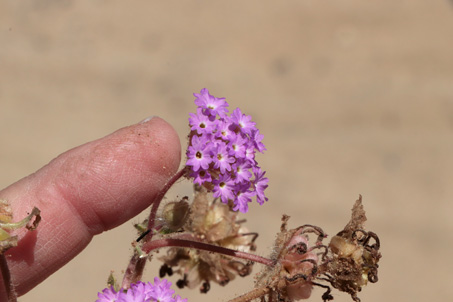
It is a little smaller and more hairy than the coastal species (A. gracilis) found to the west and farther south.
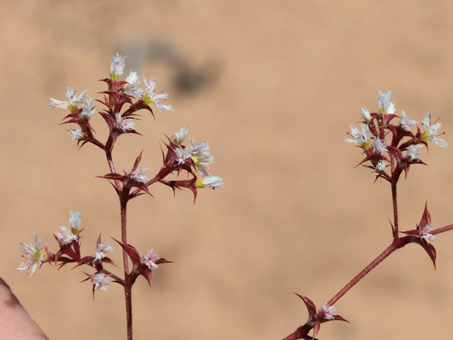
Two varieties of this Spineflower occur in the region. One spring, the hills and plains were alive with the pink tinge of var. fimbriata).
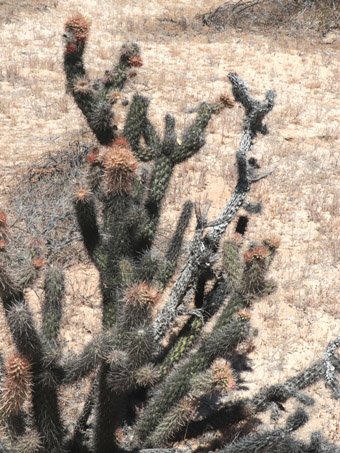
The reddish-spined version of Cataviña Cholla (Cylindropuntia ganderi var. catavinensis) occuring nearby.
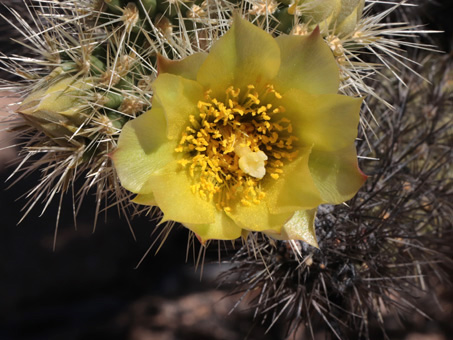
...and flowers.
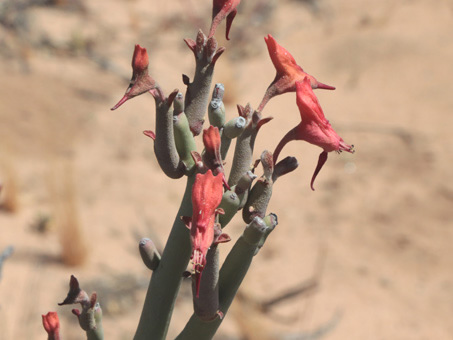
There are nectaries deep in the upper part of the flowers while pollen is delivered from the lower tip where the stamens can be seen poking out.
Central Desert North of Cataviña, BC
We had lunch in the Cataviña boulder fields. The giant granite boulders make for a fascinating and fantastical landscape. Plants grow between the rocks as if they were in a landscaped botanical garden and even find footholds in tiny cracks in the boulders.
Typical desert scrub species in this area include: Creosote (Larrea tridentata) and Guayacán (Vizcainoa geniculata); Ocotillo (Fouquieria splendens), Palo Adán (F. diguetii) and Boojum Tree (F. columnaris); Cataviña Cholla (Cylindropuntia ganderi var. catavinensis), Long-spine Cholla (C. molesta var. molesta), Red-spine Barrel Cactus (Ferocactus gracilis var. gracilis), Cardón (Pachycereus pringlei); Chuparrosa (Justicia californica), Mesquite (Prosopis glandulosa var. torreyana) and San Diego Goldeneye (Bahiopsis laciniata).
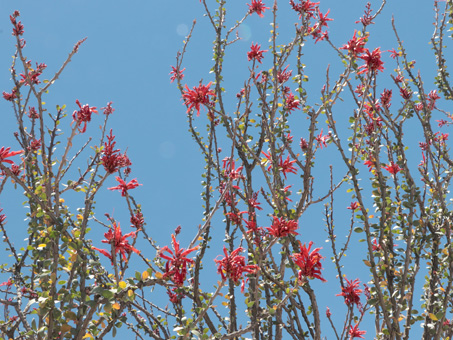
Many of the Palo Adán (Fouquieria diguetii, Fouquieriaceae) were in full bloom. The flowers are deep red.
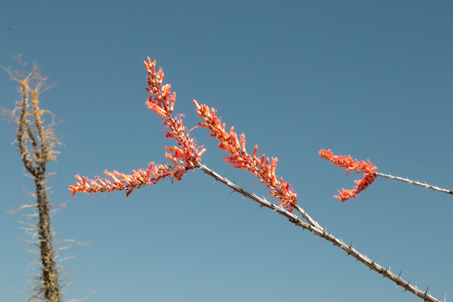
Ocotillo (Fouquieria splendens, Fouquieriaceae). The inflorescences are much longer (up to 25 cm) than those of Palo Adan.
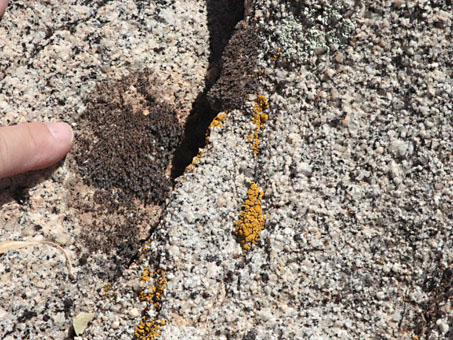
A crispy desert moss. I've been surprised to find mosses in this area growing on the top of boulders in full sun instead of the expected shady habitat. Some of the moss was growing in the shady crevice.
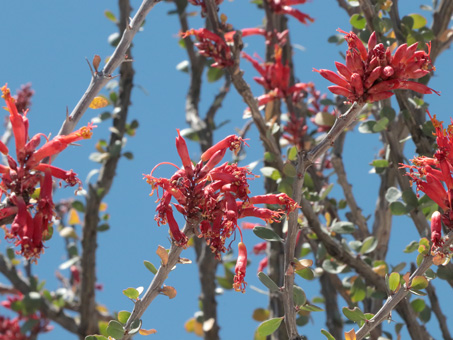
The tubular flowers are clustered in short, compact inflorescences gen. about 10-15 cm L.
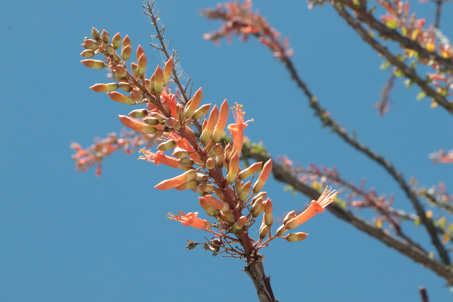
The flowers are longer as well and most of the flowers we saw on the trip were pale orange. Compare these two species.
Ecotone between Central Desert and Coastal Scrub, near El Rosario, BC
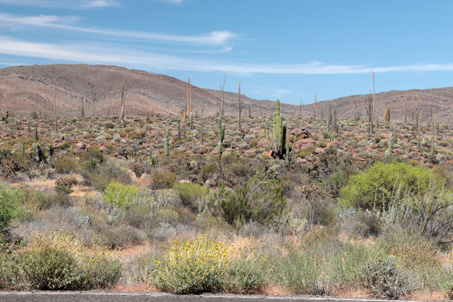 There was much more evidence of late Spring in this region. We didn't spend much time out in the field in this area, but it was green and many of the same species we'd seen farther south were evident here, many still in bloom. There were still quite of lot of tiny yellow composites covering the open spaces between shrubs and trees on the hillsides.
There was much more evidence of late Spring in this region. We didn't spend much time out in the field in this area, but it was green and many of the same species we'd seen farther south were evident here, many still in bloom. There were still quite of lot of tiny yellow composites covering the open spaces between shrubs and trees on the hillsides.
Species seen included: White sage (Salvia apiana), Brittlebush (Encelia spp.), Broom baccharis (Baccharis sarathroides), Peninsular Showy Beardtongue/ Pichel (Penstemon spectabilis subsp. subinteger, covered previously) and Cardón (Pachycereus pringlei).

White Sage (Salvia apiana, Lamiaceae), a native perennial herb or subshrub 1-3 m H. The inflorescences are spike-like. Common at roadside.
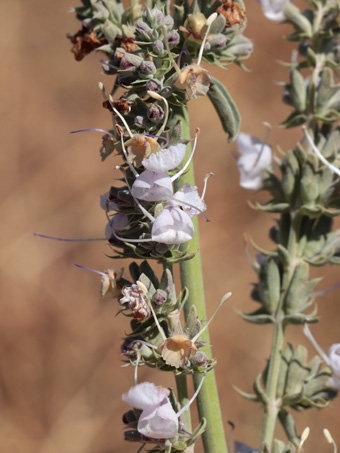
Flowers are about 12-25 mm L and 2-lipped. The leaves are large, grayish-green and thick. More photos.
That's it for this month, and the season. Hopefully we'll be back on the road in the Fall and having more botanical adventures in Baja California. Until then, hasta la próxima…
Debra Valov—Curatorial Volunteer
References
Rebman, J. P., J. Gibson, and K. Rich, 2016. Annotated checklist of the vascular plants of Baja California, Mexico. Proceedings of the San Diego Society of Natural History, No. 45, 15 November 2016. San Diego Natural History Museum, San Diego, CA. Full text available online.
Rebman, J. P and Roberts, N. C. (2012). Baja California Plant Field Guide. San Diego, CA: Sunbelt Publications. Descriptions and distribution.
Wiggins, I. L. (1980). The Flora of Baja California. Stanford University Press. Descriptions and distribution.


























